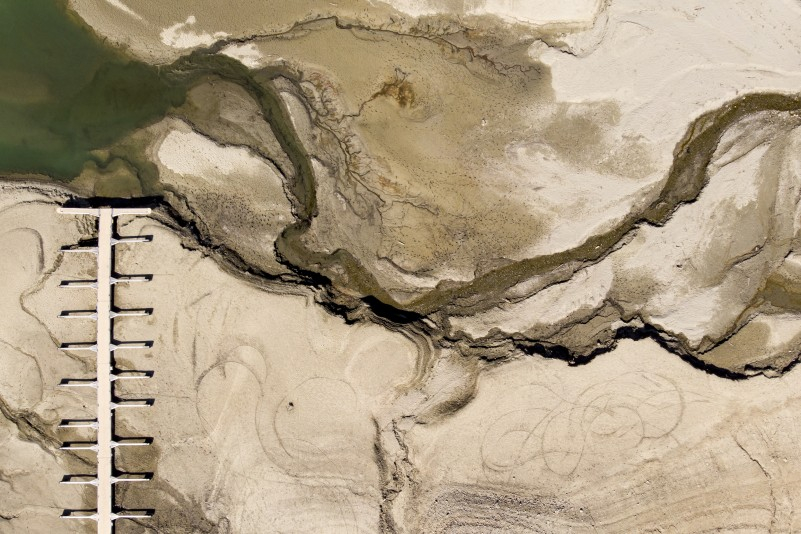Share post now
Article
Scant investment in resilience and adaptation
22.03.2021, Climate justice
Profound changes to ecological and social systems caused by global warming are now inevitable.

Boat dock on the dried-up shore of Lake Gruyère in La Roche near Bulle, Canton Fribourg (Switzerland). The water level of the reservoir was lowered by around 15 to 20 meters in April 2020 to leave enough space for the melt water. The reason for the action was the record amounts of snow.
© Laurent Gillieron / Keystone
Even if the world community succeeds in reducing all greenhouse gas emissions to net zero over the next 15 years at most,[1] numerous communities and economies are already facing challenges that are in part impossible to overcome.
The poorest and most vulnerable will be the hardest hit, not just because climate-sensitive regions are already grappling with changing patterns of rainy seasons and dry spells, ever more extreme weather events and a slow but inexorable rise in sea level.
Even five years on from the adoption of the Paris climate agreement, the affected regions and people are still awaiting urgently needed financial and material resources. And regrettably, neither was there any follow-up by way of substantial financial commitments after the usual calls – most recently heard at the Dutch Adaptation Summit early in the year – for joint action in the face of the climate crisis. The high-sounding rhetoric would then have been matched by concrete action.
According to the OECD, the public climate finance provided so far by industrialised countries for adaptation in developing countries was USD 13 billion in 2018, of which two-thirds, it is worth noting, comprise repayable loans. Under the Paris climate agreement, however, the sum should be four times as much, or half the USD 100 billion per year pledged as of 2020. Besides, the OECD confirms a criticism voiced for years by Alliance Sud (see Study and key figures, March 2020): the poorest countries received just a fraction of the amount – according to the latest OECD numbers for 2018, just 14 per cent went to least developed countries, and 2 per cent to Small Island Developing States (SIDS).
This contrasts with rapidly rising climate costs. In the annual Adaptation Gap Report[2], the United Nations Environment Programme (UNEP) estimates the current annual investment requirement for climate protection and resilience in developing countries at USD 70 billion. By 2030, annual adaptation costs in the global South will rise to USD 140-300 billion, and could be as much as USD 500 billion by 2050.
Rather than as “costs”, the Global Commission on Adaptation (GCA)[3] characterises climate change adaptation as investments with a return on investment for the economy.[4] In a report published in September 2019, it estimates that the 1.8 trillion needed for resilient infrastructure or environmental adaptation measures such as the rehabilitation of dying coral reefs or the protection of mangrove forests will yield a net benefit for the regions concerned of USD 7.1 trillion.[5] Improved protection of coastal areas not only saves human lives and buildings, but also improves drinking water quality and secures sea-based income sources. Some adaptation measures such as reforestation have a far greater benefit, e.g. helping to protect species, and even potentially contributing directly to achieving the emission reduction targets of the countries concerned.
[1] According to IPCC, the atmosphere can still support at most roughly 320 gt (billion tonnes) of CO2 equivalent, if it is to have a 66 per cent probability of not surpassing the global mean temperature by more than 1.5°C. At the current (i.e. pre- and probably post-corona) worldwide emission rate of about 40 gt/year, the remaining budget would be exhausted in seven years. On a linear reduction path, the world community would have to cut all emissions to zero by 2035, and offset unavoidable (non-CO2) emissions (e.g. from agricultural land) through negative emissions, using methods as yet hardly developed and currently highly controversial.
[2] UNEP Adaptation Gap Report 2020: As the world continues to suffer from the Covid-19 pandemic as well as increasing climate impacts, ongoing environmental degradation, food insecurity and poverty, it is urgently necessary to provide adaptation funding to address the pressing needs and immediate requirements for the survival of local communities.
[3] The Global Commission on Adaptation was originally founded by the Netherlands and now comprises 20 countries, which support its mission to „develop a bold strategic vision to accelerate climate adaptation” and be a catalyst for global adaptation solutions around the world.
[4] The Global Commission on Adaptation speaks of a triple dividend: avoided losses, economic benefits (by reducing risk, increasing productivity, and driving innovation through the need for adaptation), as well as social and environmental benefits.
[5] Global Commission on Adaptation: ADAPT NOW: A GLOBAL CALL FOR LEADERSHIP ON CLIMATE RESILIENCE. https://gca.org/wp-content/uploads/2019/09/GlobalCommission_Report_FINAL.pdf